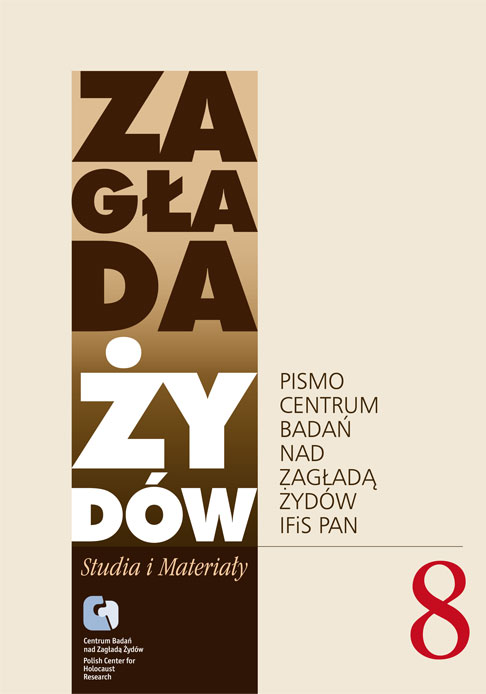Odmienne sylwetki przybyłych do Szwecji więźniów pochodzenia żydowskiego i nieżydowskiego, ocalałych z obozów koncentracyjnych na ziemiach polskich
Zagłada Żydów. Studia i Materiały, Nr 8 (2012), Strony: 419-429
Data zgłoszenia: 2020-12-06Data publikacji: 2012-12-02
 https://doi.org/10.32927/zzsim.698
https://doi.org/10.32927/zzsim.698
Abstrakt
Survivors from Nazi concentration camps, who were brought to Sweden as refugees during the last month of the Second World War and during the summer that followed, were often required to supply information about personal details to the authorities. Much of the information was later stored in written form in the Swedish National Archives. Antisemitism among the refugees and enmity between the Jewish and non-Jewish Polish refugees caused the authorities to include their ethnic or religious affiliation in many records and documents. Using mainly two collections from the Swedish National Archives it is shown that substantial differences existed between Jewish and non-Jewish Polish refugees with respect to their age, education and the length of their war experiences. These differences, in addition to the existing socio-geographic, demographic, cultural and ethnic differences led to inevitable clashes between the two groups. The Swedish authorities who first regarded all refugees of Polish citizenship as one national group had to revise this attitude gradually during the administration of the refugees
Słowa kluczowe
ocalali z Zagłady , Szwecja , stosunki polsko-żydowskie
Licencja
Prawa autorskie (c) 2012 Autor & "Zagłada Żydów. Studia i Materiały"

Utwór dostępny jest na licencji Creative Commons Uznanie autorstwa 4.0 Międzynarodowe.
https://creativecommons.org/licenses/by/4.0
Podobne artykuły
- Elżbieta Janicka, Instead of negationism. The symbolic topography of the former Warsaw ghetto vis-à-vis Holocaust narratives , Zagłada Żydów. Studia i Materiały: Nr Holocaust Studies and Materials (2017)
- David Engel, Adam Puławski, W obliczu zagłady. Rząd RP na Uchodźstwie, Delegatura Rządu RP na Kraj, ZWZ-AK wobec deportacji Żydów do obozów zagłady (1941–1942), Lublin: Instytut Pamięci Narodowej, Oddział w Lublinie, 2009, 583 s. , Zagłada Żydów. Studia i Materiały: Nr 7 (2011)
- Adam Kopciowski, Robert Kuwałek, Relacja żony Leona Feldhendlera , Zagłada Żydów. Studia i Materiały: Nr 7 (2011)
- Jan Grabowski, Dariusz Libionka, Reports on the Jews Apprehended in Warsaw During May–July 1943 Submitted by the ‘Praga’ District of the Polish Police , Zagłada Żydów. Studia i Materiały: Nr Holocaust Studies and Materials (2017)
- Justyna Kowalska-Leder, Andrzej Bart, Fabryka muchołapek, Wydawnictwo W.A.B., Warszawa 2010 , Zagłada Żydów. Studia i Materiały: Nr 6 (2010)
- Justyna Kowalska-Leder, The Omnipresence of the Righteous , Zagłada Żydów. Studia i Materiały: Nr Holocaust Studies and Materials (2017)
- Jacek Leociak, Ruta Sakowska (1922–2011) , Zagłada Żydów. Studia i Materiały: Nr 7 (2011)
- Bartłomiej Krupa, O nieobecności Zagłady, czyli czytanie Rozmów z katem Kazimierza Moczarskiego , Zagłada Żydów. Studia i Materiały: Nr 7 (2011)
- Joanna Nalewajko-Kulikov, Three Colors: Grey Study for a Portrait of Bernard Mark , Zagłada Żydów. Studia i Materiały: 2010: Holocaust Studies and Materials
- Justyna Kowalska-Leder, „Coraz to nowe żądania, coraz to nowe grymasy” – relacja władzy i podporządkowania między Polakami a Żydami w kryjówkach po aryjskiej stronie , Zagłada Żydów. Studia i Materiały: Nr 12 (2016)
<< < 1 2 3 4 5 6 7 8 9 10 11 12 13 14 15 16 17 18 19 20 21 22 23 24 25 26 27 28 29 30 31 32 33 34 35 36 37 38 39 40 41 42 > >>
Możesz również Rozpocznij zaawansowane wyszukiwanie podobieństw dla tego artykułu.
 English
English
 Język Polski
Język Polski








